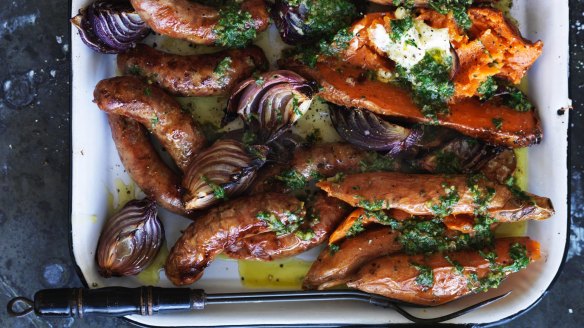Tips and recipes for one-tray wonders and traybakes
Updated , first published

One-tray wonders. Sheet-pan suppers. You've seen the cookbooks, the blogs, the artfully arranged Instagram snapshots. It can be easy to roll your eyes at the ubiquity of the concept, but there's a reason – quite a few actually – why these all-in-one dinners are so popular.
Molly Gilbert wrote one of those cookbooks dedicated to the topic. In Sheet Pan Suppers: 120 Recipes for Simple, Surprising, Hands-Off Meals Straight from the Oven she covers such well-known territory as fajitas and roasted whole fish along with creative takes that include "lasagna'd" Hasselback potatoes and Thai green curry eggplant boats. Gilbert shares some tips on how you, too, can master or widen your traybake repertoire.
Why a baking tray? More like, why not?
"Baking trays make a lot of food at once," and often enough for leftovers, Gilbert says. That real estate also means your dinner can all fit on a single piece of cookware and you'll have fewer dishes to wash. Popping a tray in the oven is a relatively fuss-free, hands-off strategy, too. One-tray wonders tend to cook quickly, making them an ideal option for busy people, even on a weeknight.
Part of the reason these dinners don't usually need a tonne of time in the oven is that a lot of recipes call for smaller cuts of meat and vegetables. The tray's low sides allow hot air to freely circulate around all sides of the food, which, when combined with the size of the ingredients, speeds up the cook time.
The right tray the right way
Go for something that is aluminum or stainless steel so it's sturdy and easy to clean. A 45cm-by-33cm walled tray, also known as a half sheet, (not a swiss roll tray), is big enough to accommodate a wide variety of meals and give you enough room between your ingredients (more on that below). If you're worried about sticking or discolouration on your tray, line it with baking paper or foil. Gilbert suggests using olive oil spray in conjunction with foil since she finds that roasted meat and vegetables can still stick to it.
Picking the best foods
Gilbert says most foods do well on a tray, especially if what you're after is something roasted and sporting an appealing crust. At the top of her list: vegetables, which she says "particularly do awesome" on sheet pans. You'll develop flavours you might not get from raw vegetables, and they'll come out crispy on the outside but tender on the inside.
Meat is another obvious candidate, from meatballs and thin-sliced fajitas all the way up to a whole chicken and leg of lamb. "I feel like a lot of meats are a little intimidating in general," Gilbert says, but there's something approachable about cooking them on a tray. Especially with a trusty instant-read thermometer in hand, you can be confident in properly cooked meat.
What doesn't work?
Gilbert struggles to think of an answer, but volunteers that pasta and rice can be tricky, although she likes to deploy frozen rice in her recipes since it is precooked and will thaw on the tray without burning. Keep an eye on anything particularly sugary, as it can burn quickly. As with all cooking, vigilance is key with traybake suppers. "It's so easy that you can forget something's in the oven," Gilbert says.
Give your food room to breathe
Some sheet-pan suppers, such as Gilbert's ratatouille (try Jill Dupleix's recipe) of tightly packed sliced vegetables on a bed of tomato sauce, rely on moist heat to cook through. But if you're going with the more obvious roasting or grilling, she says it's important not to pack your ingredients too close together. If you do, your food might steam rather than brown, and browning equals flavour.
Air circulation is important if you're cooking something that might render a lot of fat, such as burgers, in which case you'll want to place the food on a wire rack set inside the tray. Even if you're not worried about food steaming in fat, you can still pull out that wire rack so that you can cook two foods at once, such as steak and asparagus.
Think about size and timing
Don't just throw your ingredients onto a roasting tray and hope for the best. "The essence of a [traybake] meal is that it is, indeed, a meal, and the key to making the meal great is that everything you put on the [tray] has to cook in the same amount of time as its neighbours," wrote cookbook author Dorie Greenspan.
"It's a bit of a juggling act to find foods that go together and have the same cooking times, but you can usually make the dish work by paying attention to how you cut things. Chunks cook faster than wholes; chicken and fish cook faster than beef, depending on how you slice, dice and chop; and seafood cooks super fast."
You can also account for foods that cook at different rates by adding them to the tray in stages.
Have fun with it and create your own riffs
The sheet-pan supper "lends itself to so many different flavour combinations," Gilbert says. "In general, I'm sort of like a toss-pinch kind of cook," and one-tray wonders are ideal for improvising with whatever you have on hand. No matter what you want to make, "you can usually find a way on a [tray]."
The Washington Post
The best recipes from Australia's leading chefs straight to your inbox.
Sign upMore:
From our partners
Original URL: https://www.theage.com.au/goodfood/tips-and-advice/tips-and-recipes-for-onetray-wonders-and-traybakes-20190507-h1e5mb.html